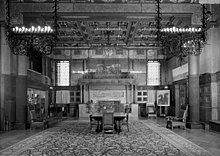William Kobbé

William August Kobbé (born May 10, 1840 in New York City , † November 18, 1931 in Pasadena , California ) allegedly rose in the US Army from drummer in the Civil War to major general .
Life
Kobbé came from a German-American family. His father, the diplomat Wilhelm August Kobbé , had married into a recognized East Coast family as consul general of the Duchy of Nassau in New York and later worked there as a businessman. William August Kobbé well attended as his siblings with relatives in Wiesbaden high school and studied after high school from 1857 at the Mining Academy in Freiberg , the mountain specialist . Here he became a member of the Corps Franconia . From 1859 to 1862 he continued his studies at the Clausthal Mountain School .
Without an exam, Kobbé returned to the United States in 1862 and enlisted in the 7th Infantry Regiment (“Steuben Rangers”) , where he began as a “drummer boy” (is not right). Militarily, he proved himself in the seven-day battle of Richmond, Virginia (1862) and in the battle of Gettysburg (1863). He became a lieutenant in 1863 and a first lieutenant in 1867. In 1872 he fought with his unit against the Cheyenne , who opposed the American government's Indian policy. As a result, he initially worked in the coastal artillery and as a teacher at the Artillery School in Fort Monroe , Virginia.
As a major, Kobbé and his battalion were used in the US war against the Philippines in 1898 . After the victory of the USA over the Spaniards in the Spanish-American War , his unit fought the insurgent units of the Filipinos in the Filipino-American War with the brutal and efficient methods of the Indian War . Colonel Kobbé received several awards in these fights. Eventually he was appointed Brigadier General in 1899 . He was ordered to take the southern part of the island of Luzon . His troops were brought to Sorsogon in the US Navy troop carriers USS Hancock and USS Garonne under the protection of the gunboats USS Nashville , USS Helena and USS Mariveles , which surrendered in the face of the American contingent. After the conquest of the region, Kobbé was appointed military governor.
In the spring of 1900 he became military governor of Mindanao and Jolo and had to take up the fight there against the rebellious Muslim Moros , who were subordinate to the Sultan of Sulu and the Sultan of Maguindanao , who were intent on a supposed autonomy. The Americans only came close to getting the Moro rebellion under control after the respected local leader of the rebels, General Emilio Aguinaldo , gave up and began to cooperate with them in 1901 . Kobbé was transferred back to his home country in 1901. His successor in the Philippines was General George Whitefield Davis . Kobbé was retired in 1904 for reasons of age with the rank of major general.
Honors
In 1932 "Fort Kobbé" on the Panama Canal was named after him, in San Francisco the "Kobbé Avenue". His New York regiment of origin, the 7th Infantry Regiment, honored him after his return from the Philippines in the New York Armory of the regiment with the gift of a sword. His grave of honor is in the San Francisco National Cemetery in the Presidio of San Francisco .
Fonts
- Notes on Strategy and Logistics. Fort Monroe 1896 ( digitized Internet Archive ).
literature
- Horst-Ulrich Textor: Major-General William August Kobbé. In: then and now. Volume 55, 2010, ISBN 978-3-87707-781-8 , pp. 149-170.
- Guy V. Henry: Military record of civilian appointments in the United States Army . Vol. 1, New York City, London 1864, p. 364 ff. ( Google Books ).
- Dr. Rüdiger B. Richter and Hans-Georg Balder: Corporated in the American Civil War , 2nd expanded edition, 2013, WJK-Verlag Hilden, ISBN 3-944052-21-2 , pp. 88–97.
Individual evidence
- ↑ Today Corps Franconia Fribergensis in Aachen in the Weinheim Senior Citizens' Convention ; As an old man , Kobbé kept in touch with his corps even after his retirement.
- ↑ The USS Marivelis was under the command of the young William Daniel Leahy , later Fleet Admiral of the US Navy.
- ↑ Fort Kobbe
- ^ New York Times, February 1, 1902.
| personal data | |
|---|---|
| SURNAME | Kobbé, William |
| ALTERNATIVE NAMES | Kobbé, William August (full name) |
| BRIEF DESCRIPTION | American officer, most recently major general; Military Governor of Mindanao and Joló (1900) |
| DATE OF BIRTH | May 10, 1840 |
| PLACE OF BIRTH | New York City |
| DATE OF DEATH | November 18, 1931 |
| Place of death | Pasadena , California |



